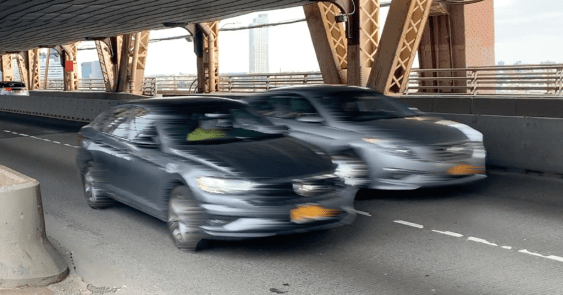The city is looking for a new vendor to run its automated traffic enforcement program and better catch drivers blocking their license plates, after its current camera operator routinely missed reckless drivers due to the obstructions.
Department of Transportation contractor Verra Mobility tossed more than 40 percent of pictures it took of drivers last year — resulting in a loss of more than $100 million in fines to hundreds of thousands of unaccountable drivers, according to the city comptroller's office.
DOT put out a request for proposals this week for a new five-year contract, noting that the agency "specifically seeks to leverage recent innovations in camera-based technology to tackle more recent on-the-ground challenges, including the growth in obscured license plates," according to an official press release.
The operator chosen will run the nation's largest automated camera enforcement program against drivers who speed, blow red lights and block bus lanes beginning in 2025, and be expected to install new camera equipment by August of that year.
A report by Comptroller Brad Lander earlier this year found that Arizona-based Verra rejected 41.5 percent of photos its machines snapped before a DOT analyst could even review them, up from 36.6 percent the year before. Some cameras had rejection rates as high as 92 or even 98 percent.
Obscured and defaced plates comprised the largest share of rejected tickets, a growing problem documented at length by Streetsblog.
However, DOT was "unable to access videos or images to determine whether rejected speeding events were properly excluded by Verra," Lander's office found, leaving the company's decisions without proper oversight.
Verra rejected almost 750,000 speeding incidents because of temp tags or no tags at all — a potential loss of $37 million in just the first six months of 2023, Lander's review found. The company dismissed another approximately 320,000 incidents for speeding by emergency services.
Rejections due to drivers having a temporary paper license plate — which DOT has admitted the cameras cannot read, regardless of whether they're real or fake — rose more than 5,000 percent between 2019 and mid-2023, another issue Streetsblog has also long documented.
The cameras still work to reduce the number of tickets and crashes where the city sets them up, according to DOT figures showing their demonstrated positive impact on safety.
"Our automated enforcement programs are the envy of cities around the country, as they have been key to our Vision Zero efforts to save lives on our streets," said DOT Commissioner Ydanis Rodriguez in a statement Wednesday.
"Through this RFP, we are looking for a company to work with us to keep these programs going strong. We encourage all qualified companies to apply."
Verra could reapply to keep running the system, and a spokeswoman for the company said the firm will review the RFP.
"With challenges such as absconded and ghost plates impacting the effectiveness of automated enforcement programs, we look forward to reviewing this RFP, and we will continue to adapt and innovate our cutting-edge technology to meet the needs of New Yorkers for decades to come," said Valerie Schneider in a statement.






